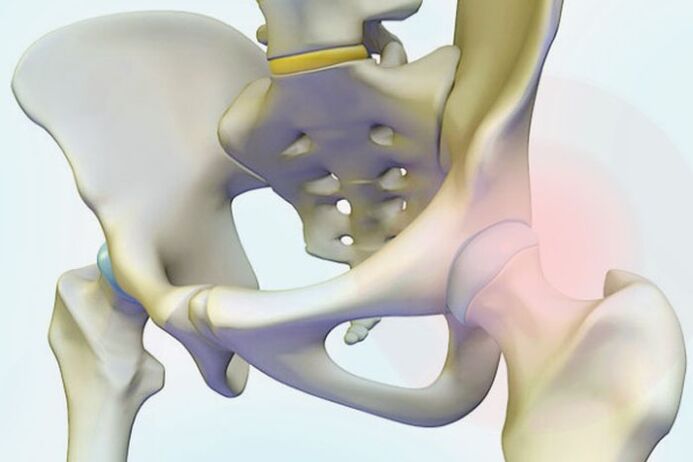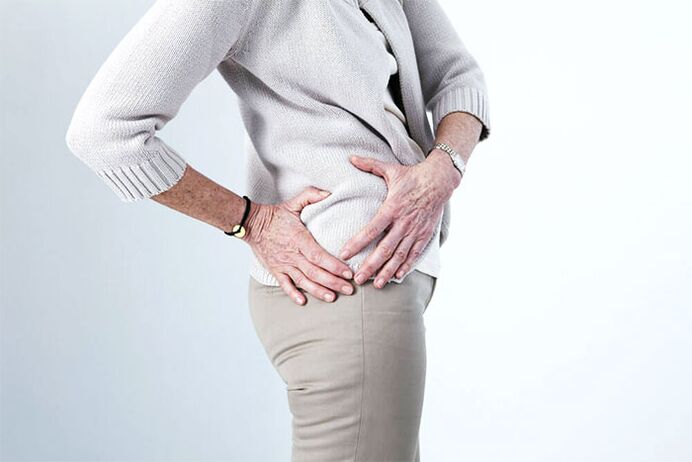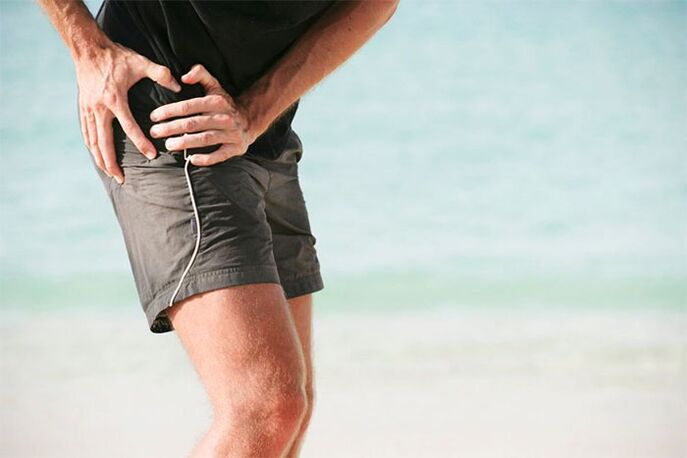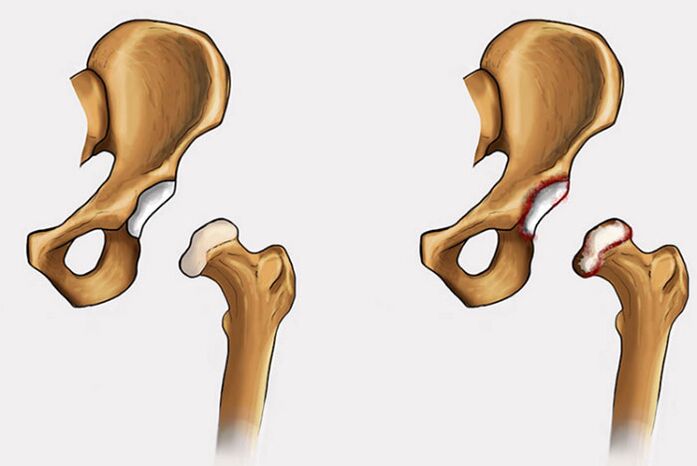
If you feel pain in the hip joint, you need to determine the cause.Treatment of pain depends on the pathology, the symptom of which.Comprehensive measures and strict adherence to recommendations help to get rid of the disease and maintain the motor activity of the joint.Impaired functioning of the hip joint makes active movement impossible.Reduced functionality limits the patient's independent movement and work.

Anatomical features
A large joint connects the femur and pelvic bones and can move in three directions: flexion and extension, abduction and rotation of the lower limb.Degenerative changes that lead to deformity, limit movement and cause pain.
The hip joint is supplied with blood through the main arteries of the femur, localized in the area of the joint.Pathologies that can disrupt vascular capacity lead to oxygen starvation and nutrient deficiency.
The large nerve trunks of the sciatic, obturator and femoral nerves provide innervation.Compression or pinching of nerve endings causes intense neurological pain in the pelvic area.
Causes of hip pain
The development of diseases of various etiologies in the area of the hip joint leads to serious health problems, including disability.The occurrence of pain in the hip joint accompanies all pathologies at different stages of development.
The cause of the pain determines its nature and intensity.Acute pain occurs as a result of injuries, inflammatory, purulent processes, while painful, non-intense sensations arise from chronic diseases.
Many pathologies of unknown origin and congenital disorders lead to the appearance of symptoms.The syndrome is initially present or may appear as a result of the progression of the pathological condition.

Inducing diseases
- Traumas of varying severity are one of the most common causes.Bruises, sprains and fractures cause mechanical damage to bones and ligaments.On the first day after the injury, a sharp pain is observed in the hip joint.After that, the pain weakens and goes away.Common injuries: pelvic fracture, hip dislocation, femoral neck fracture.All of the above injuries occur after a direct, serious injury from a fall or blow.The situation becomes more complicated if a person has a history of osteoporosis or degenerative changes in the cartilage and bone tissue of the joint.
- Myositis ossificans is characterized by inflammation of the connective tissues of the joint capsule.Appears after injury or if inherited from parents.The progressive course leads to morphological changes in the cartilage tissue, which degenerates into bone formations over time.
- A dislocated hip, whether it develops at birth or in the womb, leads to deformities, limited movement and pinched nerves.With this pathology, not only somatic but also neuropathic pain occurs in the hip joint.
- Coxarthrosis is a common pathology of elderly people who lead a sedentary lifestyle or do heavy physical work.Dystrophic changes in the cartilage and subsequent bone deformation cause pain.The first symptoms appear as a result of intense stress.The advanced course is accompanied by constant dull pain that does not go away during rest or prolonged sleep.The aggravation of the syndrome continues in parallel with the progressive changes of the hip joint.
- Arthritis - inflammation of the joint capsule is accompanied by severe throbbing pain.It can appear as an independent disease or as a complication after an injury or infectious disease.
- Reiter's syndrome is a reactive change of an allergic nature, which most often occurs after infectious pathologies.There are cases when the condition develops after chlamydia or gonococcus invades the joint capsule.The pathology is accompanied by acute pain in the hip joint and swelling of the tissues.
- Rheumatoid arthritis is a systemic disease of the immune system in which the body's own cells recognize healthy tissue as foreign and attempt to destroy it.This condition leads to the modification of joint tissues against the background of severe inflammatory processes.
- Ankylosing spondylitis is a chronic systemic disease of the joints.The localization of the process in the iliosacral region is accompanied by pain in the pelvic area, mainly at night.The patient's pain intensifies in the morning, stiffness disappears after active movements or exercise.
- Osteochondritis dissecans, also known as Koenig's disease, develops in the cartilage that contacts the femur.The cartilage begins to delaminate with further separation of a small area.The condition is often complicated by the addition of synovitis.Patients complain of pain in the hip joint;in the final stage, complete blockade occurs due to the presence of necrotic cartilage tissue in the joint cavity.
- Legg-Calvé-Perthess disease is a disease similar to osteochondropathy, which develops when the blood circulation and nutrition of the hip joint is damaged.It is characterized by gradual necrosis of the femoral head, which is accompanied by pain and gait disturbance due to the acquired shortening of the limb.The disease is considered pediatric, as children of preschool and primary school age are more often affected.
- Bursitis is inflammation of the synovial bursa, which is filled with pathogenic fluid.The disease appears in the bursae located near the hip joint and causes pain mainly during exercise or palpation.
- Synovitis is an inflammatory change of the joint membrane lining the wall of the joint capsule.In the acute period, there is constant severe pain in the hip joint;during the chronic course, the symptoms subside.
- Symphysitis - changes in the tissues of the pubic symphysis with deviation of the pubic bones.It occurs during pregnancy and childbirth.The pathology is inflammatory in nature, accompanied by severe pain in the vulva, which spreads to the area of the hip joint.
- In the pelvic area, radicular syndrome is represented by neuropathic pain.The syndrome develops due to the compression of large nerves located at the junction of the femur and pelvic bones with bone growths and deformed tissues.
- Varus foot deformity, clubfoot, can be a congenital defect or an acquired condition.Improperly distributed load due to the inward displacement of the forefoot negatively affects the hip and knee joints.Over time, due to improper measures or lack of treatment, the hip joint becomes deformed, causing pain.
- Enthesopathy is a degenerative-dystrophic process in the ligaments of the joint.The processes are often accompanied by inflammation.The painful condition leads to the weakening of the structure of the ligaments and tendons with the eventual rupture of the connective tissue.In addition, ossification of certain areas occurs, which reduces the functionality of the joint.
- Intermittent hydrarthrosis is a chronic joint pathology in which there is an increased synthesis of synovial fluid, accompanied by an increase in joint volume and a decrease in motor activity due to pain.
- Synovial chondromatosis is the degeneration of areas of the synovial membrane of the joint into cartilaginous formations.New growth can reach the size of a matchbox.It is accompanied by severe pain during movements, a decrease in amplitude up to complete occlusion of the hip joint.
- Juvenile epiphysiolysis is a pathological displacement of the femoral head downwards and backwards.Boys get sick during puberty, when there is a malfunction due to the disruption of the synthesis of sex hormones and growth hormones.Pain in the hip joint when trying to move the leg.
- Aseptic necrosis of the femoral head may develop due to acute circulatory insufficiency of the hip joint.Against the background of the death of bone tissue, intense pain turns into a burning sensation, which sharply limits the ability to move the affected leg.Attacks last for several days and pass before the next acute phase begins.
- Cases are known when gout develops in the hip joint.Excessive formation of uric acid with insufficient secretion crystallizes and settles in the joint cavity, gradually filling it.During a gout attack, pain occurs that cannot be tolerated.
- Malignant tumors in the bones or surrounding tissues.
Symptoms
Pain in the hip joint is divided into 3 degrees:
- mild - accompanied by minor injuries and consequences after intense stress affecting the muscles of the thigh and buttocks;
- medium - occurs with pathologies of a dystrophic, inflammatory and infectious nature, they can be local or radiate to the lower limb or pubic bone;
- strong - occurs with bone fractures, severe dislocations, accompanied by severe movement restrictions in the joint, and sometimes paralysis.
Pain that progresses at night and goes away during the day appears in pathologies associated with blood vessel congestion.Lack of blood circulation can cause numbness, tingling and a crawling sensation.
Many diseases occur with inflammation in the joint capsule, ligaments or surrounding tissues.
In this case, characteristic symptoms appear:
- swelling around the hip joint appears due to a violation of the outflow of excess fluid, while the skin stretches and becomes shiny;
- change in the color of the skin in the painful area: from moderate red to bluish;
- local temperature increase in the joint area due to the reaction to acute inflammation;
- its severe course causes general poisoning of the body, accompanied by headaches, joint pains and fever.
Methods of diagnosing the hip joint
For a detailed examination, a number of tests are carried out, which can be used to create a complete picture of the disease that has arisen:
- the laboratory blood test indicates latent or obvious inflammation, the presence of rheumatoid factor;
- bacteriological examination of joint fluid to determine the causative agent of inflammation;
- biopsy of suspicious tissue for the presence of malignant factor;
- X-ray examination of the hip joint from different sides helps to identify signs of tissue deformation;
- ultrasound examination of the joint;
- The Doppler ultrasound method for assessing blood circulation;
- computed tomography.

Treatment of the hip joint
If the hip joint hurts, therapeutic measures may vary depending on the disease.It all depends on the pathology, the symptom of which is unpleasant pain.The range of procedures is determined by the methods of drugs, physiotherapy treatment, physiotherapy and alternative medicine.Strict adherence to recommendations and compliance with all regulations will lead to normalization of the condition.Only a doctor can prescribe drugs and medicines.
Drug therapy
- Anesthetic drugs can be used for temporary pain relief.Painkillers do not treat the cause of hip pain, but they effectively relieve the symptom for a short time.
- In case of severe pain, if non-narcotic pain relievers do not work, a blockade is performed.
- Nonsteroidal anti-inflammatory drugs are used as anti-inflammatory, pain-relieving, and antipyretic agents.The drug should be taken strictly according to the instructions, without exceeding the dose, so as not to cause side effects from the gastrointestinal tract.
- Glucocorticosteroids have a positive therapeutic effect in the case of severe inflammations that cannot be treated with non-hormonal drugs.Steroid hormones provide anti-inflammatory, analgesic and antihistamine effects.During the injection, they can be injected directly into the diseased joint.
- Antibiotics are prescribed for associated purulent infections.Antibacterial agents have a harmful effect on the pathogen, they destroy the cause of the pathology.Along with antibiotics, the patient is prescribed probiotics to normalize the intestinal microflora.
- Muscle relaxants - effectively relaxes muscles, eliminates spasms.Medicines reduce the volume to the point of immobilization, relieve pain in the pelvic area.
- Diuretics remove fluid, prevent swelling and negative effects on heart function.
- Vitamin therapy is used to strengthen immunity and improve general well-being.The biochemical processes that ensure the body's vital functions take place at an optimal speed.
- In the case of degenerative processes that destroy the joint, chondroprotectors are taken for a long time in order to stop the degenerative process and recover independently.The drugs contain chondroitin and glucosamine, the lack of which causes an imbalance in the joint.Medicines are used in tablet form and are also injected into the joint.
- Tranquilizers for unbalanced mental states.A nerve disorder occurs when a person experiences constant, debilitating pain in the hip joint.
- Angioprotectors to improve blood microcirculation.They improve metabolic processes in the walls of blood vessels and increase their permeability.
Physiotherapy treatment of hip pain
Modern methods of complementary therapy provide pain relief in the affected area and help to quickly get rid of the pathology.Modern medicine has many ways to relieve hip pain.
Each method is assigned the following purpose:
- improves blood circulation in the tissues of the hip joint;
- reduces inflammation;
- relieves pain;
- prevents the development of edema;
- improves metabolic processes in cells;
- initiation of tissue self-healing processes;
- strengthens the immune system.
Laser therapy allows you to influence the joint, penetrating up to 9 cm.Laser beams directed at the affected area heat the thickness of the tissue down to the bones.The healing effect on nerve processes dulls the pain.This method is designed to relieve inflammation;the pain-relieving effect is additional.
Electrophoresis is the application of galvanic current to penetrate deep into tissues.Along with anti-inflammatory or pain-relieving drugs, a low-strength and low-voltage direct current is prescribed for administration through a chemical reaction.
Magnetic therapy ensures the penetration of the magnetic pulse current to a depth of 7-12 cm.The treatment is carried out in courses, the effect is achieved by the end of the treatment period and lasts until the start of the next treatment.A device that relieves pain and initiates regeneration processes is suitable for improving the health of the hip joint.
Shockwave therapy involves short-term exposure to low-frequency acoustic pulses.It is used to eliminate inflammatory manifestations, providing a kind of high-frequency massage.Increased collagen synthesis begins, blood supply and tissue trophism improve.
Orthopedic medical products
A reduction in the manifestation of hip joint pain can be achieved with the help of orthoses and rehabilitation devices.Modern developers of medical products have taken care in advance of the possible difficulties that patients have to face.
Injuries involving the neck of the femur require months of complete immobilization.In order not to put a massive plaster cast on the entire lower limb, there is an orthosis with a degree of rigid fixation - "derotation boot".It is convenient for the patient to use the product in practice, it is safe from the point of view of the allergenic effect (plaster causes skin irritation and allergies), and for others, the care of the victim's feet.
An anti-decubitus mattress is indispensable if a person has to lie there for many months.During the rehabilitation period, when they take the first steps after the injury, they first use a walker for independent movement.When greater stability appears, crutches are used, and then a stick, which provides support while walking.
Symphysitis causes a lot of suffering due to severe pain in the pubic and pelvic area.In order to alleviate the painful condition, an orthopedic corset is used for the hip joint, for compression and support with the help of rigid ribs, and for the pelvic ring.
Choosing the right shoes is of great importance in terms of the proper relief of the hip joint.The shock-absorbing preventive insoles for everyday wear alleviate not only problems with the joints, but also problems with the spine.
The applicator has proven to be effective in relieving pain and improving blood circulation.The plastic needles in close contact with the painful area first cause pain, turning into a pleasant warmth.In the acute period, the treatment time is from 5 minutes to 6 times a day, in case of chronic pain, from 15 minutes three times a day.

Therapeutic gymnastics
Exercise therapy classes have a special role.The more movement a joint performs under measured load, the more synovial fluid is produced, which is necessary for tissue nutrition and performance.A set of exercises is put together by the medical instructor for each patient.
The exercises are performed in the remission phase, when there is no pain.The technique of correct execution of the movements is explained by a physiotherapist and reproduced under the supervision of a specialist.Movements should not be sharp or sweeping;the number of repetitions must be exactly as instructed.
Physiotherapy improves blood flow, tones the thigh muscles, increases the motor ability of the pelvic joint, facilitates walking and improves immunity.All exercises must be coordinated;incorrect actions cause a pain attack, increased blood pressure and the appearance of microtraumas leading to inflammation.
A series of home exercises:
- in a lying position, bend your knees at a right angle, pull both legs to your chest at the same time, creating slight resistance with your hands;
- Without changing position, pull your bent legs up one by one, holding for a few seconds;
- lying on the right side, raise the left leg, bending at the knee, repeat the same operation with the other leg;
- in a prone position, stretch your arms along the body, raise the straightened leg 15 cm, hold for 5 seconds and perform movements alternately with both legs;
- sitting on a chair, raise your legs parallel to the floor, repeat the movements with each leg.
Surgical treatment of the hip joint
If conservative treatment does not bring the desired result, surgery is performed to alleviate the patient's condition.There are several ways of surgical care:
- Arthroscopic debridement - cleaning the inner wall of the joints from necrotic particles, followed by washing with a medicinal solution.The manipulation is performed in the operating room.
- Periarticular osteotomy - the bones of the joint are broken so that they join at a different angle to reduce the load on the diseased joint.
- Endoprosthesis is the replacement of a diseased joint with an artificial one;the method includes active rehabilitation actions after surgery.

Traditional medicine
Affordable and safe recipes from healers with centuries of experience help relieve hip joint pain and speed up recovery.Before use, you should consult to rule out contraindications.
- Peel and chop a head of garlic, add chopped celery root and a lemon with its peel.Mix all the ingredients, add hot water, leave in a cool place for a day.Take 1 spoon for thirty days.
- Linden and birch bud tea can be drunk every day to reduce inflammation.Boil a teaspoon of linden flowers and birch buds in hot water.After 30 minutes, the decoction is ready for use.
- Prepare a mixture of herbs: St. John's wort, chamomile and immortelle, combine 1 tbsp.Pour the preparation into 500 ml of water and boil for 10 minutes.Take the product with 50 ml three times a day.
- Cut the turnip into small pieces, add a little honey and 30 ml of vodka.Apply the resulting mixture to the painful joint and secure it with plastic wrap on top.Cover the poultice with a warm blanket for the whole night.
- Mix mustard powder with honey and vegetable oil.Gauze folded in several layers is dipped in the preparation and placed on the joint.Keep the poultice for no more than 60 minutes.
- Wash the cabbage leaf and apply honey to the hip joint area.Honey has antibacterial and anti-inflammatory properties, and cabbage relieves pain in affected joints.
- Crushed celandine leaves are mixed with a small amount of olive oil.The mixture is infused for 7 days and then used to rub the painful area.
- Hop cones and St. John's wort should be cut up and mixed together, and vaseline should be added to an ointment-like consistency.Rub it into the painful joint twice a day.
- Mix red pepper, kerosene and vegetable oil and leave for 3 weeks.Use for rubbing at most once a day.
Prevention of hip joint
In order to prevent pain in the hip joint, simple recommendations will help:
- the lifestyle should be active, with regular light physical exercises;
- proper nutrition is the basis of health: exclude fatty, salty and smoked foods, alcohol, sausages, chocolate, sweets;
- do not overload the joints with tiring physical activity or heavy work;
- use preventive bandages to relieve the burden on the pelvic joint;
- wear comfortable shoes that meet orthopedic standards;
- If unpleasant symptoms appear in the area of the hip joint, see a doctor for an examination and prescribe an effective treatment.























